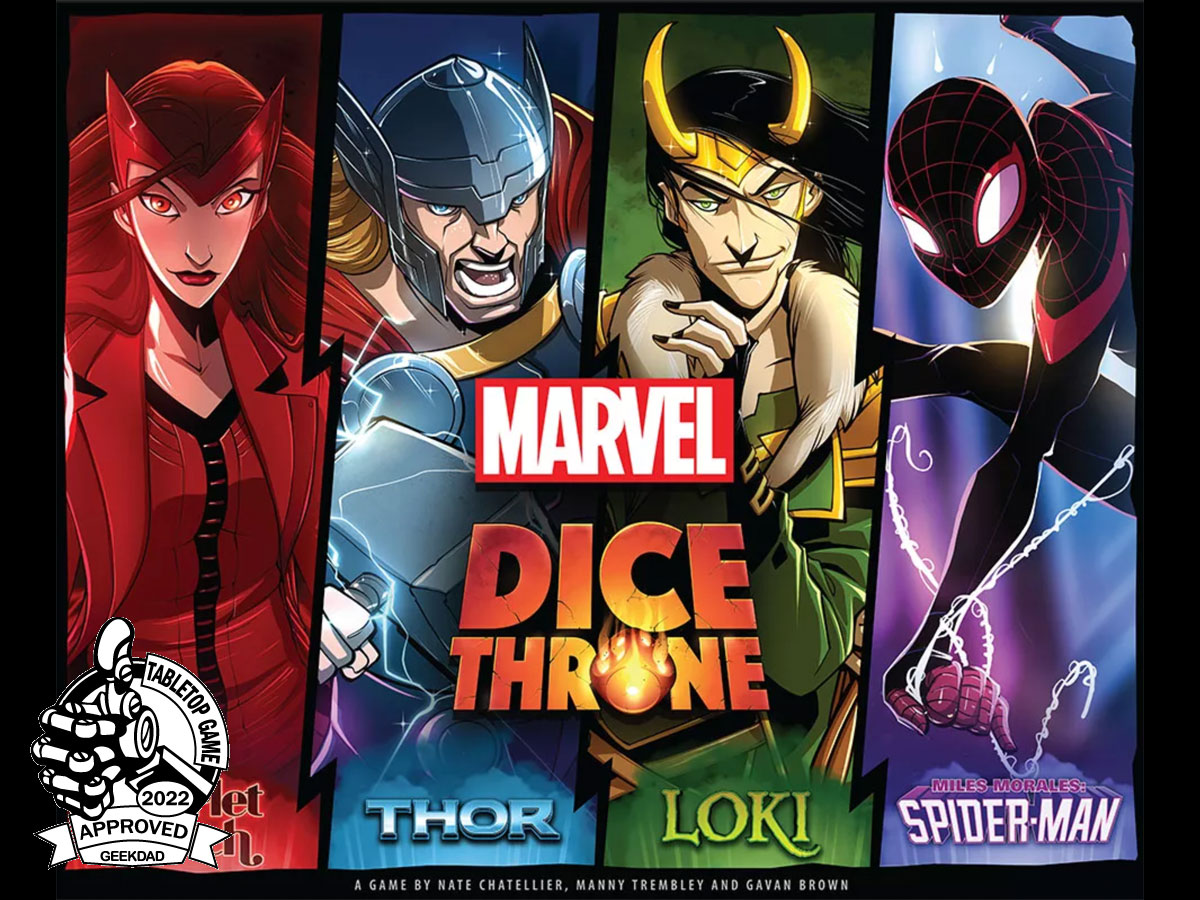Marvel characters have entered the Dice Throne universe, and it’s a great combo.
What Is Marvel Dice Throne?
Marvel Dice Throne is a Marvel-themed version of the dice brawling game for 2 to 6 players, ages 8 and up, and takes about 30 minutes to play. The game was originally funded through Kickstarter and included a single box with 8 characters. The retail version comes in three separate sets, one with 4 characters and two with 2 characters each:
- Scarlet Witch v. Thor v. Loki v. Spider-Man
- Black Widow v. Doctor Strange
- Captain Marvel v. Black Panther
The 4-character box retails for $49.99, and the 2-character boxes retail for $29.99. They’re available in stores and directly from The OP. The Kickstarter edition Battle Chest (containing all 8 characters) is available from Roxley Games for $109.
Marvel Dice Throne was designed by Nate Chatellier, Manny Trembley, and Gavan Brown. It was published by Roxley Games and The OP Games, with illustrations by Manny Trembley, Nick Malara, and Damien Mammoliti.

Marvel Dice Throne Components
Each hero comes with its own Gametrayz organizer that holds all of its components. The original Dice Throne had large player boards and mats, with small open trays that held the dice, cards, and other components, but in later editions these were replaced by a tri-fold board and larger trays with lids. The trays also have an extra well for cards so there’s enough room for sleeved cards.
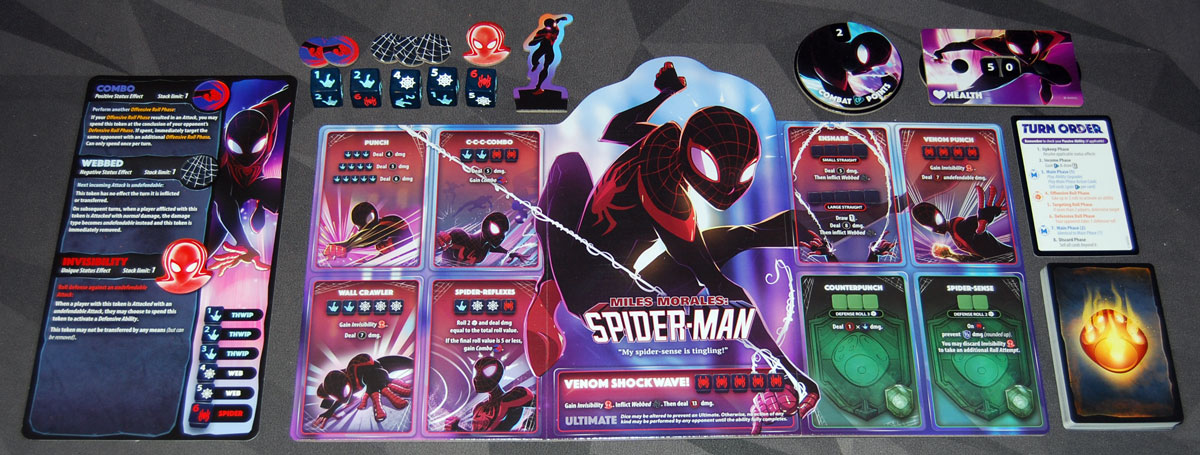
Each character includes:
- Hero board
- Hero leaflet
- Tokens
- 5 dice
- Combat Points dial
- Health dial
- Card deck (about 32 cards for most characters)
- Player Reference card
- Character standee
The tokens vary from character to character depending on their abilities, but everything else is fairly uniform across the characters. The hero board has a large character portrait in the center, with 8 card-sized sections for abilities, and an ultimate ability below the portrait. The leaflet has details about the character on one side (including the character’s gameplay complexity level), and an explanation of the various tokens as well as a list of the 6 faces of the custom dice.

Just for reference, here’s the complexity level of the characters:
- Black Panther – 2
- Captain Marvel – 2
- Spider-Man – 2
- Thor – 3
- Black Widow – 4
- Loki – 4
- Scarlet Witch – 4
- Doctor Strange – 5
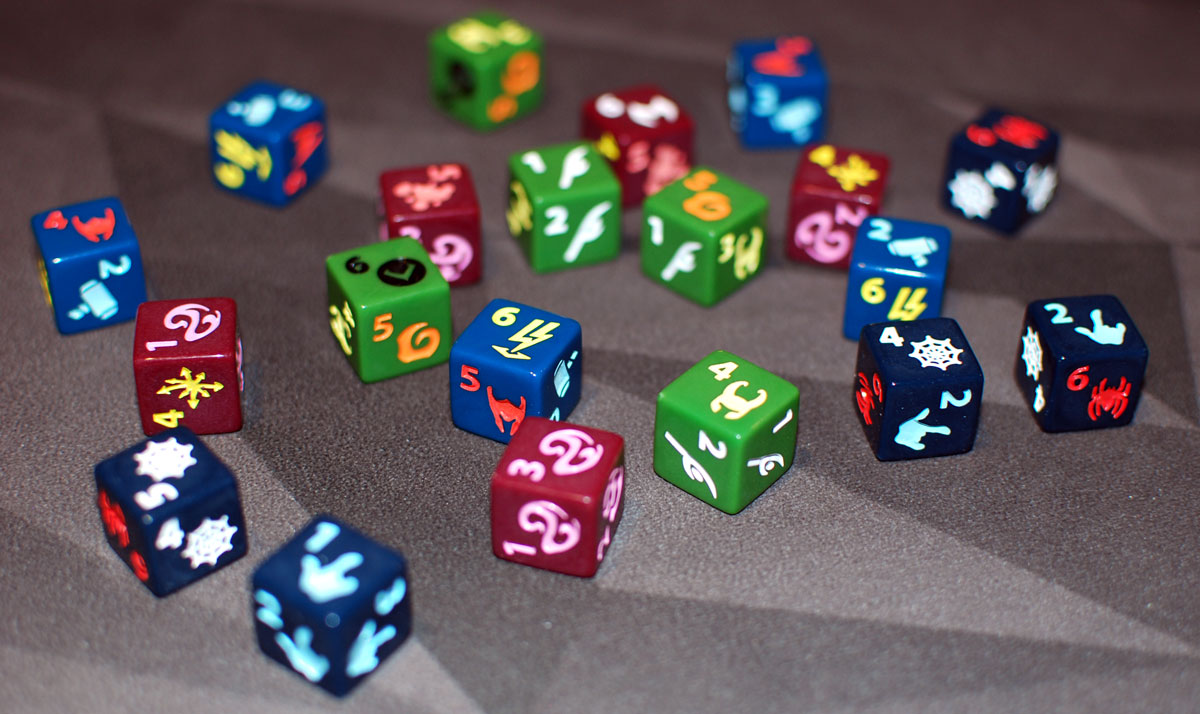
Each character’s dice are unique to them—they’re labeled 1 to 6, but have different icons and colors. What’s more, the particular number and mix of icons also varies. Most characters have 3 different symbols, but some of the higher complexity characters (e.g., Loki and Doctor Strange) have 4 symbols. The dice themselves have different base colors for each character, and the faces are engraved and painted.
The dials are nice and sturdy—the health dial has two digits and the CP dial is a single dial that goes from 0 to 15. Both include illustrations of the characters as well.
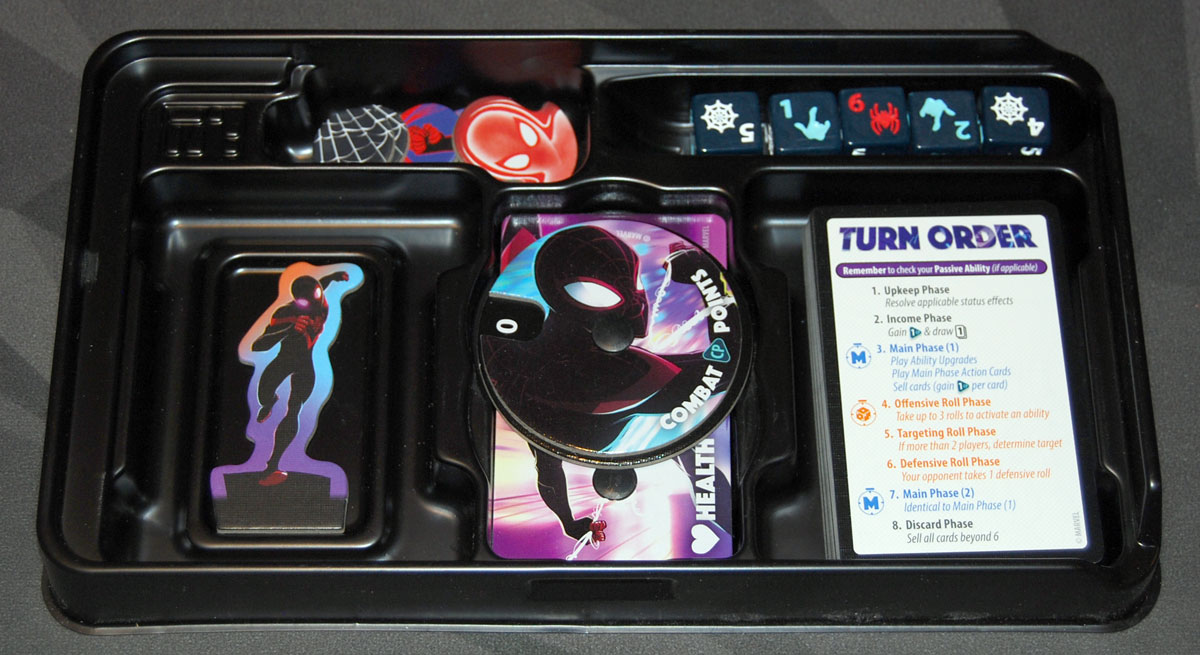
Each character also comes with a cardboard standee (though no plastic base to stand it up). These are presumably just for fun to use the extra space on the punchboards, because they’re not actually used in the game (or even referenced in the rulebook). Have fun with them, I guess!
The game boxes themselves are sized to hold the trays plus the rulebook (which is the same for all three sets), and that’s it. However, because of the thickness of the boxes, that means that the three sets don’t stack nicely: two 2-character boxes side-by-side are wider than the 4-character box. It’s a minor nitpick, but it feels a little off when they’re on the shelf.
How to Play Marvel Dice Throne
You can download a copy of the rulebook here. The rules for Marvel Dice Throne are the same as for the base Dice Throne game.
The Goal
The goal of the game is to eliminate all the other players. Look, I know all of these characters are the “good guys” except for Loki, but you know how Marvel comics are: there’s always some excuse for the good guys to fight each other.
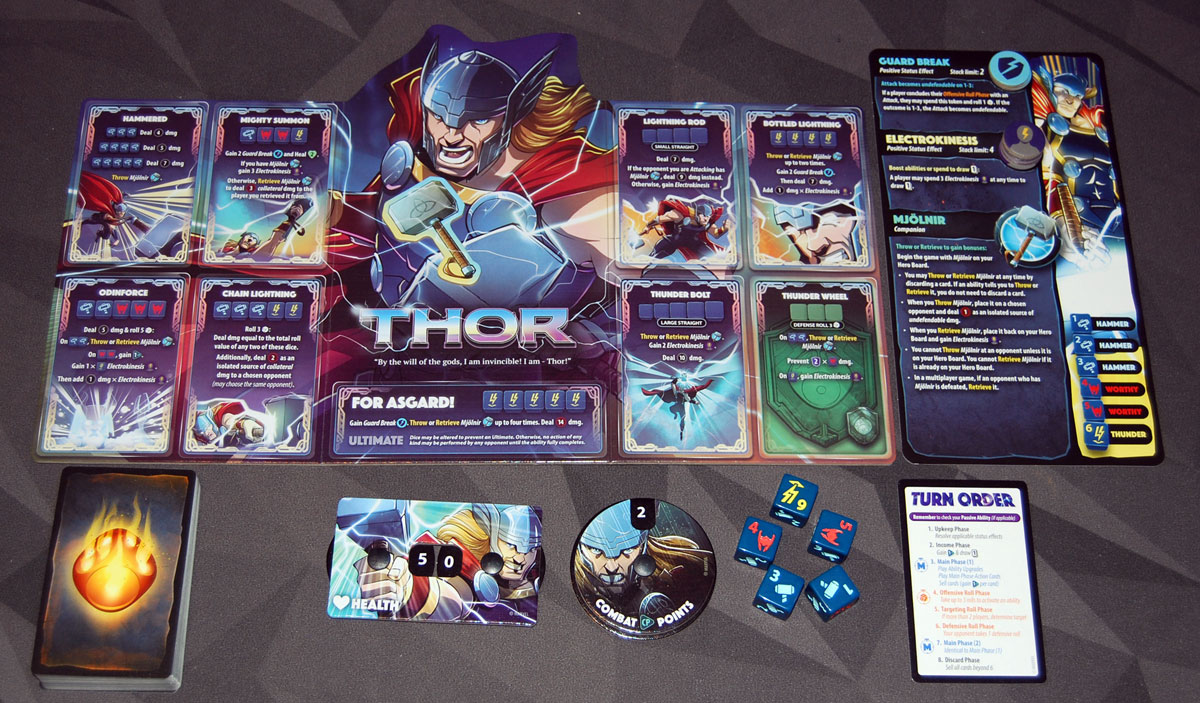
Setup
Give each player a set of character components. There are a few ways to play: free-for-all, or in teams of 2 or 3, but in general setup is similar, but starting health is lower when there are more players. Each player sets their CP dial to 2, and their health to the starting health based on the number of players. (Your maximum health is 10+ the starting health.) Each player shuffles their own deck of cards and draws 4 cards.
Some characters will have additional setup, indicated on the leaflet. For instance, Thor starts with Mjolnir on his board.
Gameplay
Your turn consists of these phases:
- Upkeep
- Income
- Main Phase 1
- Offensive Roll
- Targeting Roll (with more than 2 players)
- Defensive Roll
- Main Phase 2
- Discard
Upkeep: Apply any applicable status effects. For instance, many status effects will do damage at the start of your turn.
Income: Gain 1 CP and draw 1 card.
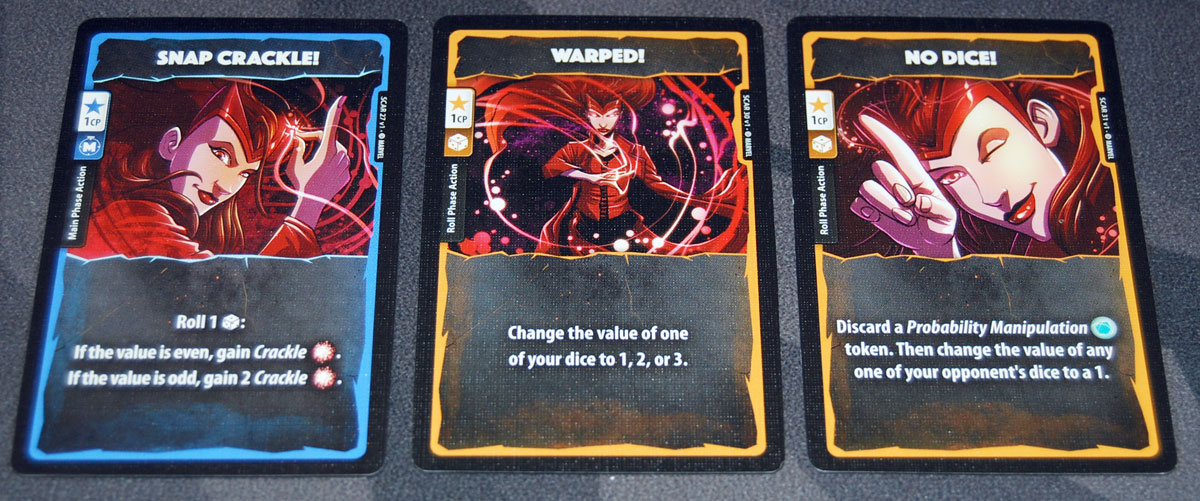
Main Phase 1: You may sell cards by discarding them for 1 CP each. You may play cards that have the “M” icon on them by paying CP for them. Some cards are one-time-use effects, and some are upgrades to abilities on your board. Effects are played and discarded, and upgrades go on your board in the relevant slot. If you upgrade an ability that has already been upgraded (e.g., from Level 2 to Level 3), then you only need to pay the difference in CP.
Offensive Roll: This is where you get to attack somebody! You get three rolls, Yahtzee-style, where you can keep some dice and re-roll the remainder. After you are finished rolling, you look at the icons you rolled and choose one of your powers to activate.
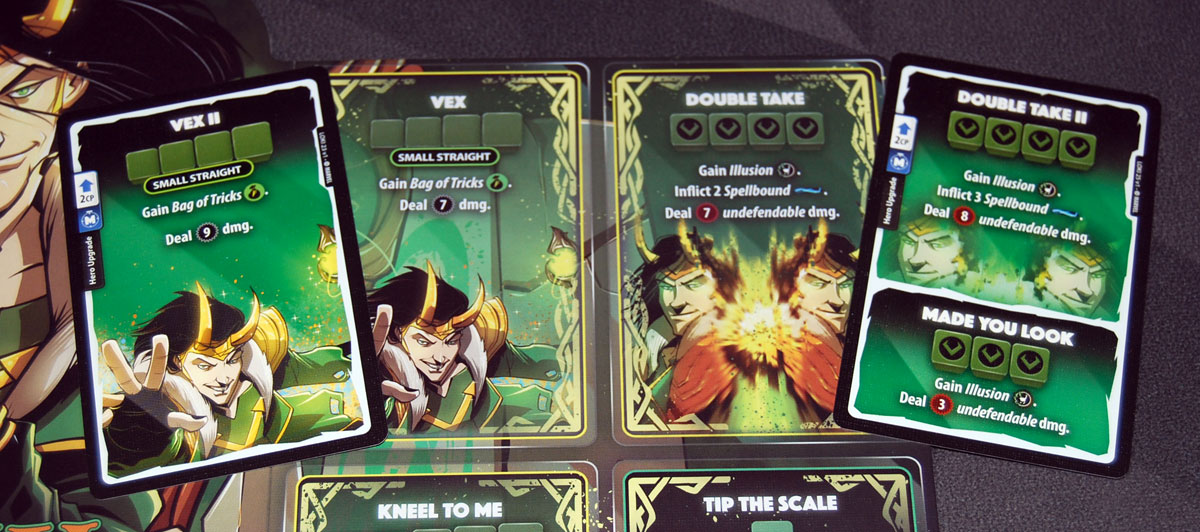
Targeting Roll: For team-based games, you will roll a die to randomly determine which of your opponents is being attacked, if the power you’re using needs a specific target. In a free-for-all game, you can attack anyone you want, but will draw 1 card if you attack the leader—the player with the most health.
Defensive Roll: The player being attacked may use a defensive ability (shown in green on their hero board). There are a few different types of damage—some are undefendable, in which case the defender cannot make a defense roll, but they may still be able to use status effects if applicable.
Main Phase 2: Same as before.
Discard: Discard/sell cards down to your hand limit of 6 cards.

Cards have an icon that indicate when they can be played: during your own main phase, during any roll phase, or anytime. That means a lot of cards can be played during somebody else’s turn, perhaps allowing you to manipulate their dice or move status effects around.
Each player also has an Ultimate Ability at the bottom of their board, which is activated if they roll all 6s. While opponents may try to play cards to change the dice, once the ability is actually triggered then nobody can do anything until it finishes resolving, which means you cannot use your defenses or status effects to help you against an Ultimate Ability.
Game End
The game ends when all but one player (or team) is out of health, winning the game. In the case that multiple players or teams run out of health on the same turn and there is nobody left, then there is no winner.
Marvel Dice Throne is GeekDad Approved!
Why You Should Play Marvel Dice Throne
I reviewed the original Dice Throne back in 2017 and gave it a GeekDad Approved at the time—I liked the mix of Yahtzee-style dice rolling and unique player powers. I did have some complaints about it, but most of those were addressed in later editions—for instance, they dropped the 2-player learning game that ignores the cards and combat points, presumably because it’s easy enough to learn the whole game at once. For a free-for-all game, they eliminated the targeting roll and let you just pick any target, but there’s an incentive to attack the leader because you get a bonus card. Although I didn’t get any of the later sets for review myself, I’ve seen the continued popularity of the Dice Throne series as more characters were added and even a cooperative dungeon crawl adventure.
The core of the game remains the same: your attacks are powered by certain combinations of dice, whether it’s multiple matching faces or a small straight, and generally the lower-probability combos activate more powerful abilities. You frequently have to decide whether to take the easy combo that perhaps doesn’t do as much damage, or go for the large straight (but risk striking out entirely). You’re not left entirely to luck, though: many of the cards or status effects will help you manipulate your dice, as long as you’ve saved enough combat points to pay for them.
What Marvel Dice Throne brings to the table, of course, is the characters from the mega-franchise that, let’s face it, a lot of us have been completely immersed in, whether through the comics or movies or games. That’s not for everyone, admittedly, but if you’re here reading tabletop reviews on a site called GeekDad, I’m guessing there’s a pretty good chance that Marvel Dice Throne will hit a lot of the right notes for you, as it did for me. You get to roll dice, play cards, and take on the role of a superhero (or … Loki).
I’m not sure how they decided on this particular set of characters (or the pairings, in the case of the 2-hero sets), but I have enjoyed this set. Presumably we may eventually get other characters—personally, I want to see what they’d do with the Hulk. It may be that since Marvel Dice Throne is completely compatible with the other Dice Throne sets, they started with characters that wouldn’t be too close mechanically to any of the other characters that already exist.

The designers have done a really good job of capturing the feel of the various characters and adapting them to this game system. Loki has an illusion ability where an attacker has to choose one of three cards, hoping to score a direct hit. Miles Morales doesn’t do massive damage, but has a combo ability that lets him string together multiple attacks (plus he can turn invisible to avoid attacks). Black Widow is all about finding her upgrade cards and improving her very specific skill set.
I also appreciate the fact that the characters have varying complexity, which makes it easier to play with a group that has mixed levels of experience and preferences. If you like casual games and rolling dice but don’t want to agonize over what to do on your turns, there are plenty of level 2 heroes that let you dive into the game quickly. On the other hand, if you like building up card combos and you want a bit of a challenge to master a character’s special abilities, the higher level heroes will give you more to puzzle through.
In short, I liked Dice Throne a lot already, and I think it pairs really well with the Marvel setting. It’s a winning combo, and I look forward to getting more practice with the various characters!
For more information, visit the Dice Throne website.
Click here to see all our tabletop game reviews.
![]() To subscribe to GeekDad’s tabletop gaming coverage, please copy this link and add it to your RSS reader.
To subscribe to GeekDad’s tabletop gaming coverage, please copy this link and add it to your RSS reader.
Disclosure: GeekDad received a copy of this game for review purposes.
